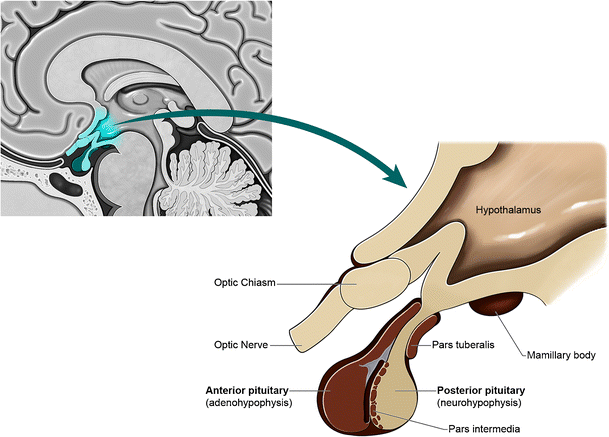Pituitary fossa

The pituitary (hypophyseal) fossa or sella turcica is a midline, dural lined structure in the sphenoid bone, which houses the pituitary gland.
Gross anatomy
The anterior, inferior and posterior walls are bony, while the lateral walls and roof are formed by dural slings between the anterior and posterior clinoid processes (see below). There is a fenestration in the roof of the pituitary fossa for the infundibulum. There are four parts to the pituitary fossa although some authors describe the sella synonymously with the fossa:
- anterior: tuberculum sellae
- posterior: dorsum sellae
- inferior: sella turcica
- superior: diaphragma sellae
Contents
- pituitary gland
- pituitary vessels
- anterior and posterior intercavernous sinuses
- CSF (superiorly only, in the hypophyseal cistern)
Relations
- anteroinferior: sphenoid sinus
- posterior: clivus, basilar artery, brainstem
- superior: suprasellar cistern, optic chiasm, infundibulum, hypothalamus
- lateral: cavernous sinus
Size
- length of less than 15 mm
- depth of less than 12 mm
Variant anatomy
- enlarged fenestration in the diaphragma sellae can result in empty sella sign
- pneumatization of the dorsum sella
Dural anatomy
There is, perhaps surprisingly, some controversy about the exact anatomy of the dural layers of the pituitary fossa and adjacent cavernous sinuses. A generally accepted description, which has the added benefit of being epistemologically easier to visualize and understand, is to think of the pituitary fossa as being formed by a sac of only the visceral (meningeal) layer of the dura mater, with the parietal (endosteal) layer only being present where there are bony structures (anterior, inferior and posterior) .
This meningeal layer is continuous with the lateral wall of the cavernous sinus, passing up and over the pituitary fossa as the diaphragma sella. Centrally within the diaphragm, a depression is formed which represents the pituitary fossa. Therefore, the lateral walls of the pituitary fossa, between the pituitary gland and the cavernous sinus, are formed by a single layer of meningeal dura . This also helps visualize the presence of intercavernous venous communications that can be seen below the pituitary gland (between meningeal and endosteal layers) .
It is worth noting, that in addition to the aforementioned 'dural sac', the anterior lobe of the pituitary also has its own capsule .
Only superiorly is there as a small recess of CSF, the hypophyseal cistern, which is located above the anterior lobe of the pituitary gland, and in front of the infundibulum. When enlarged this cistern can fill and even expand the sella (particularly in the setting of intracranial hypertension) and result in a largely empty pituitary fossa.
Siehe auch:
und weiter:

 Assoziationen und Differentialdiagnosen zu Sella turcica:
Assoziationen und Differentialdiagnosen zu Sella turcica:
